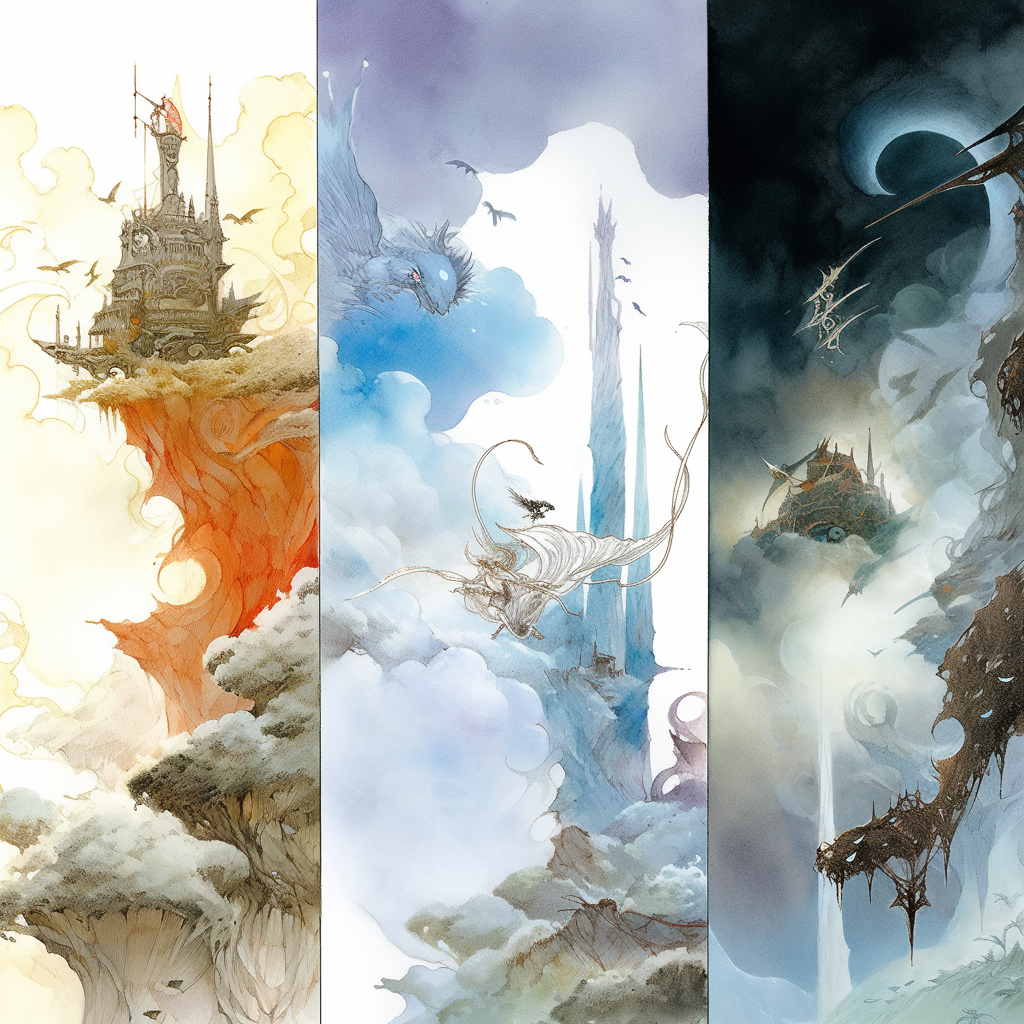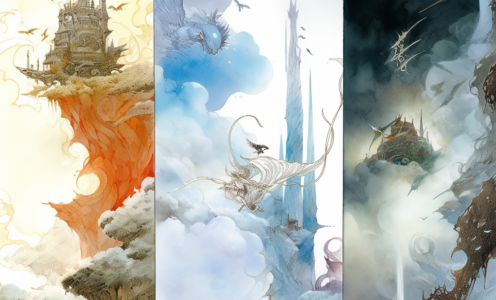Classification of Prime Planets by Primary Elemental Type
by Talgrind Washerman, FOO (A&AD)*
In our continuing survey of the known multiverse, we at the Fraternity have turned our attention to to the Prime Plane. My department is conducting a survey of Prime Worlds in a number of ways, and this article represents our classification system. Most planets and other celestial bodies are either creatures (constellates, starbeasts, etc. Liveworlds too perhaps) or elemental pockets. ‘Pocket’ worlds for the 18 inner planes are described here:
Earth: An earth world is a typical planet or moon. Made of rock or earth, it will tend to be any size from pebble-sized up to about three times the size of Oerth or Toril, which seem to be typical of worlds supporting planewalkers, and may have an atmosphere and/or support life in many forms. They sometimes form clusters: Toril’s Selune Tears and Mystara’s twin moons are examples of these.
Ooze: Ooze worlds are enormous heaps of slimy mud floating through the void. Inhabited mainly by ooze mephits and used as dumping grounds by spacefarers, they can develop into liveworlds if they support enough swamp-loving plant life. Sussurri, shambling mounds and muckdwellers can be found on fertile oozeworlds.
Water: A water world is a globe of pure(ish) water in space. In spheres with sub-zero wildspaces, all water worlds will be near to hot bodies or have atmospheres. They support elemental water life, fish, and possibly floating islands. Popular as bases for pirates, who can moor large numbers of ships to floating stages on the surface, waterworlds also attract the spacegoing whale-kin, kindori and great dreamers.
Ice: Also called coldworlds, ice planets resemble water worlds but are frozen. They are found almost exclusively in spheres with subzero wildspace, and support ice mephits and cold-loving creatures like winter wolves and frost giants. Some have molten cores and are unstable, behaving like endless glaciers. At least one such world is known to be used by yugoloths to train troops, so vulnerable to the cold, to fight in frozen environments such as Stygia and Cania.
Air: Air worlds are huge globes of gas drifting in space. Not all are breathable, and sizes can be up to a thoiusand times the size of a typical earth body, hence the expression ‘gas giant’, used by spacefarers. The reader should note that air worlds have little or no prevailing gravity, and if they contain earth islands, these will support their own gravity planes and wells like normal asteroids do. Dragons love air worlds, as do elemental air creatures, aarakocra, avariel and tempests.
Smoke: Smoke worlds are rare, and tend to be barren and inhospitable. Gravitational conditions resemble those on air worlds, but the atmosphere is considered toxic. Only tempests and smoke mephits like it here, and perhaps a few antisocial dragons. Ships visiting smokeworlds should beware of being hit by the large cinders that circulate in these planets’ convection cells.
Fire: Fire worlds are usually stars of red, orange or yellow colours, tending to have a radiance component as they grow more yellow. For white stars, see radiance and positive, and for brown stars, see magma. Fire worlds are inhabited mainly by elemental fire creatures, as even red dragons find these worlds unpleasant for any great length of time. Visitors to fireworlds should think twice.
Magma: Magma worlds vary in nature according to size. A small magma world will be a volcanic moon or planet, and will be inhabited by magma mephits and magmen. A larger one will more closely resemble a brown dwarf substellar object, or brown star. Light given out is minimal, but surface temperatures are in the region of 1000 degrees celsius, and heat-loving plants may inhabit the moons of such a body. Red dragons and other heat-loving creatures sometimes dwell on lavaworlds.
Positive Energy: Positive worlds are white, blue and green stars. They are incredibly hot and bright, and tend to promote desert-like conditions on the surrounding planets. Approach with extreme caution. Uninhabitable, except by strange alien beings from positive energy.
Mineral: Mineral worlds are rare, but tend to be ore- and gem-rich earth-type worlds. They seldom support life, due to the purity and harshness of the local materials. Inhabitants may include gem dragons, mineral quasi-elementals, and a large number of quasi-elemental mineral creatures like those found in the realm of the quasi-elemental lord Crystalle. [see Dragon Magazine #174].
Mist: Mist worlds are like air worlds, but a lot damper. Inhabitants will be similar, with plenty of mist dragons and mist and steam mephits. Ships entering mistworlds had best be warded against damp and dry rot, as nothing can be persuaded to dry in a mistworld, and ships leaving them have very moist air envelopes.
Radiance: Radiant worlds are cold, bright stars, like ‘white dwarf ‘objects. Quasars may also be radiant worlds, but this is unconfirmed due to the rarity and remoteness of quasars. Practically uninhabited, apart from by blind dragons and radiant mephits, radiant worlds are desolate and nearly-useless.
Lightning: Lightning worlds are unstable, and can only exist in the presence of mist or smoke worlds. Such agglomerations are called nebulae, and are dangerous to enter. Lightning manifests itself infrequently for short periods in isolation in the void, usually as a result of the so-called ‘stellar wind’ effect. Such discharges are also dangerous, and many ships entering windspheres carry lightning rods to protect against such phenomena.
Ash: Ash worlds are like warm, barren earth worlds, and support only ash and dust mephits and a few other bizarre creatures such as ash crawlers and the odd blue dragon. If an ash world has an atmosphere, it is automatically considered fouled, due to the tainted nature of the ashes making up the planet.
Salt: Salt worlds superficially resemble mineral worlds, but tend to have moist, salty atmospheres. They support only salt mephits and are no use unless you need dirty salt. There are never any useful mineral deposits on saltworlds, and pirates occasionally hide near them to avoid attention.
Dust: Dust worlds are constantly shifting barren desert worlds. They have no stable surface, and landing on one is just asking to see your ship vanish in a dust storm. Dust mephits and a few lonely earth creatures hang out here, along with blue dragons and the odd purple worm, preying on unknown energies.
Vacuum: Vacuum worlds are only theoretical objects, as they are usually indistinguishable from wildspace, and if they come into contact with other worlds, they are destroyed. Occasionally a vacuum pocket appears in an earth, salt or mineral world, where the local matter is not pliable enough to fill it. In such cases, the planet affected may become unstable and suffer earthquakes as a result.
Negative energy: Negative worlds include black holes, which are obviously best left alone, and sargassos [described in Lost Ships]. They are havens for undead and bizarre tainted magics, and both the Doomguard and the Dustmen are conducting parallel researches into them for their own purposes.
*: FOO (A&AD) – Fraternity of Order, Astronomy and Astrology Department.
Source: Alex Roberts


